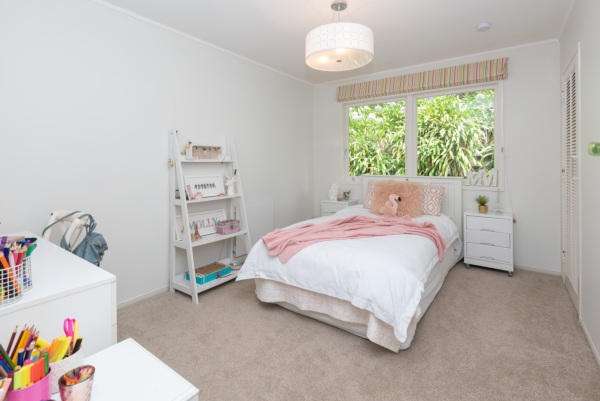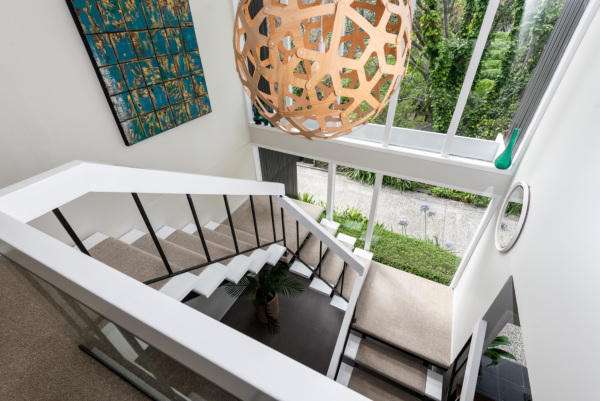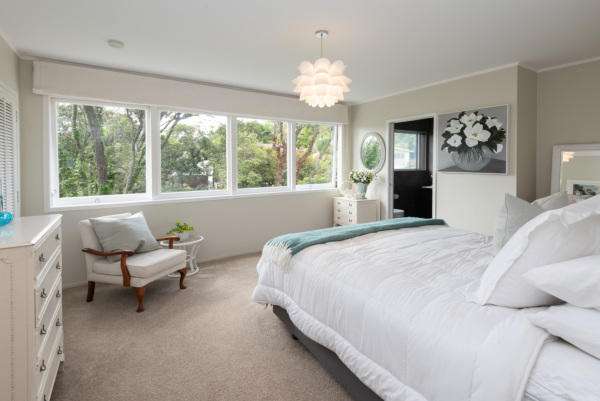Sarah Kerr has been an interior designer for more than 20 years, and has often worked with developers and homeowners to stage their houses for sale.
She’s clearly got an experienced eye. And right now that is being put to the test as she is selling her family home of 10 years. Kerr says that people comment on how tidy and well-presented it is – even with kids aged 12 and 9 years.
“I do say ‘we live like this’ anyway, the kids have been very good,” she laughs.

Start your property search
Interior designer and home stager Sarah Kerr says that, luckily, her kids keep their rooms pretty tidy - just what buyers want to see. Photo / supplied
“For most people, the clutter issue is a key one – and that means you can’t get a feel for a space because there’s no room, even inside the cupboards, or under the beds or the garages. It’s huge!”
“We do get complacent in our own home. I have to admit that after 10 years here, I’ve put more effort in the last three years. “
Kerr has specialised in home staging for developers, with the challenge there of adding soul to neutral cookie cutter spaces that have never been lived in. But she says the principles are the same for houses where people live.

Kerr says not to strip out personality of your house - she has introduced modern and vintage touches that complement her 1960s house she is selling. Photo / supplied
She honed her skills for a few years as one of the designer/presenters for television show “Changing Rooms”, where a room had to be transformed on a tiny budget in a matter of days.
“You think about what the feeling is, what to highlight and what are the best features to bring out. Is there a great stairwell? Seating that makes the most of the light or views?”
Kerr is not fond of staging that removes all hint of character from a home so that it looks exactly the same as any other house. In her own 1960s property, she’s mixed old and new, playing up the mid-century character with vintage German pottery, but admits that it is quicker and easier to make decisions for other people’s places.
“I can see that this item can be used here instead of there – I steal a painting from one room to put somewhere else.
“I think staging pays off for buyers, they couldn’t have the imagination but now they visualize themselves in it.”

The key accessories for all the home stagers are great bedding, including plump cushions and welcoming throws. Photo / supplied
Kerr says that rather than renting furniture, her developer clients give her budget to buy entire house lots. For smaller clients, often finishing touches are all that are needed to buy: a great rug, some cushions for colour and plants. For bigger changes, she’ll do a walk through advising updates on paint colours, window trims, adding mirrors and paintings.
Her favourite change agent is great bedding – fresh linen, Euro pillows, a good valance and a throw. She also updates lighting, going so far as changing bulb colours to warm up a space.
On average, if vendors are staging a full house, they’d expect to pay around $5000.
Staging has spread from only high end large family homes – with staging budgets that can top $8000 to $10,000 or more – to tiny city apartments. Former property manager Megan Feneridis spotted a gap when her company sales people were struggling to shift rental apartment.
Feneridis had flipped a few of her own apartments, so knew the things that helped potential buyers envisage making a life in the small spaces. She launched Nook Staging nearly four years ago to help other apartment owners do the same.
“We use clever items that don’t bulk up the space, with a light Scandinavian feel that shows people they can still have a lifestyle in an apartment. We sell the dream, with plants and homely touches so it doesn’t look sterile.”
Unlike other staging companies, which have the chore of packing out all the merchandise once a property sells, many of Nook’s clients’ buyers also buy the house lot of furniture.
“We have an eye for the layout, people can imagine having a few friends over for drinks and dinner without being restricted. We show a space is flexible and can use in multiple ways, and we ‘de-sterilise’ an apartment space.”
When much of her marketing reach is on Instagram, it’s not surprising that Feneridis has her finger on the pulse of what triggers buyers. Right now, that’s bar carts, with drinks and glasses (“It shows you can still entertain.”)
More recently, Nook Staging is working in city fringe developments like Albany, Stonefields and Hobsonville Point, as well as KiwiBuild projects in Flat Bush, targeting a very different market.
“There, it’s not investors, it is first home buyers, young families. People can see these are the right size, and they can go well there, in style.”
She’s also had high demand from investors buying city apartments as Airbnb rental, fitting them out with homely touches like candles, throws and kitchen equipment.
She also does partial staging, working with existing furniture in sellers’ homes, combining it with an interior action plan to rearrange and de-clutter a house, with hands-on arranging and a few key pieces.
“Clients say they wish we’d done it years ago. You do have to have an ‘eye’ and most people just can’t see it themselves, or they don’t have the time or inclination.”
In Wellington, Emma Bell of Homestaging Wellington says that in the four years since she bought the company where she’d been a stylist, the market has grown from four staging companies to around 12. These range from top of the range $8000 fit outs to a budget niche “$1000 stage, with stuff from K Mart and the Warehouse.”
A lot of her work is with former rental properties, where smart new furniture is brought in to enhance the newly re-painted and re-carpeted space. She is also used to working with traditional homes, bringing in new pieces to update the owners’ older furniture with a partial stage common.
“Owners can do their own de-clutter based on what we recommend. Or we’ll get the moving boys to just put stuff in the garage for the owners to sort.”
Bell always removes family photos, and likes using colour. Her favourite accessories at the moment are real live house plants, and coloured cushions. If she adds rugs, in the interests of full disclosure, she always lets the agents know if they are hiding damaged flooring.
Like other stagers, she loves it when owners return to their staged house and “get a pleasant shock. They didn’t know their house could look so good.”
Homestagers’ Top Tips
1.Colour is important, but designer Sarah Kerr also recommend paying attention to smells in the house, adding fresh lemons, basil or mint for subtle scent, using soft music for atmosphere and adding texture and natural materials for the sense of touch.
2. Great bedding is an easy transformation to bedrooms. Stagers generally have sets of pillows, duvet cover and throws that are only used for open homes, put away between showings.
3. De-clutter more than just the visible parts of the room – buyers will open cupboards, look under beds and garages and sheds, so make sure they are clear and empty too.
4. Large items on the wall – a big painting, a mirror – make a small space seem larger. Simple roller blinds make windows seem bigger and lighter than curtains.










